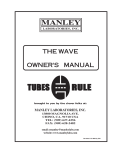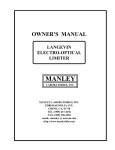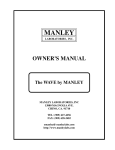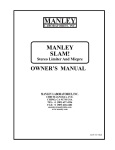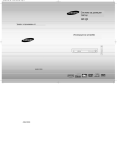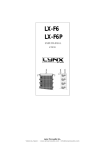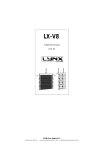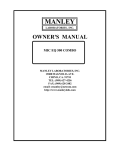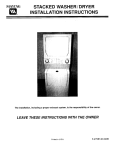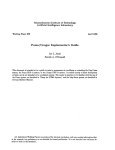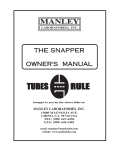Download Manley Langevin Dual Vocal Combo Owner`s manual
Transcript
OWNER'S MANUAL LANGEVIN DUAL VOCAL COMBO MANLEY LABORATORIES, INC. MANUFACTURED BY: MANLEY LABORATORIES, INC. 13880 MAGNOLIA AVE. CHINO, CA. 91710 USA TEL: (909) 627-4256 FAX: (909) 628-2482 email:[email protected] http://www.manleylabs.com REV. 5-01-01; "P" SUFFIX CONTENTS SECTION PAGE INTRODUCTION 3 FRONT PANEL 4, 5 BACK PANEL 6 MIC PRE BASICS 7 CONNECTING YOUR PREAMPLIFIER 8, 9 OPERATION NOTES 10, 11 SPECIFICATIONS 12 TROUBLESHOOTING 13, 14 INTERNAL ADJUSTMENTS 15 INTERNAL LAYOUT 16 REPLACING FUSES 17 MAINS CONNECTIONS 18 WARRANTY 19 WARRANTY REGISTRATION 20 APPENDIX A: WIRING YOUR OWN CABLES 21 APPENDIX B: TEMPLATE FOR STORING SETTINGS 22 INTRODUCTION THANK YOU!... for choosing the Langevin Dual Vocal Combo. Manley Labs bought all the rights to the Langevin name and circuits in 1992. Manley uses the Langevin name for its solid state products including versions of an all discrete Pultec and Electro-Optical Limiter, and Mic Preamp. The Dual Vocal Combo is the result of a suggestion to combine the "Langevin Dual Mono Microphone Preamplifier with EQ" with the "Langevin Dual-Channel Electro-Optical Limiter" for a competitively priced stereo or 2 channel VoxBox-like product. Both the mic preamp and the Langevin EL-OP are recognised as great values and serious high performance all-discrete professional units. While the combination is not quite a "solid state VoxBox" because it doesn't have some of the compressor & EQ functions and no de-esser, it is 2 channels of the "essentials" for half the price. The "Combo" is 100% discrete transistor in the signal path and there are no op-amps except to drive the LEDs in the Opto circuit, and the Meter circuit. Negative feedback is minimal, only one transformer (mic input) per channel and much of the components are the same as in the Manley tube gear. While we were planning this unit we upgraded the front panel Instrument Inputs for higher input impedance (150K ohms) and higher gain (25 dB more) so virtually all guitars, bassers and synths and drum machines could be recorded direct-to-tape comfortably. Thank you again, and please enjoy! WATER & MOISTURE As with any electrical equipment, this equipment should not be used near water or moisture. If liquid enters the preamplifier, it must be immediately returned to your dealer for servicing. SERVICING The user should not attempt to service this unit beyond that described in the owner's manual. Refer all servicing to Manley Laboratories. WARNING! ! TO PREVENT THE RISK OF ELECTRIC SHOCK DO NOT OPEN THE CABINET REFER SERVICING TO QUALIFIED PERSONEL 3 A INPUT B C 80 Hz D L.F. E EQ IN F H.F. G H I H G POWER 12 KHz OFF ON PHANTOM by Manley Laboratories Inc. 40 Hz DIRECT INPUT IN -10 -1 +10 GAIN GAI EQ OUT -10 -1 REDUCTIO REDUCTION +10 8 KHz E 80 Hz L.F. D C EQ IN H.F. B A 12 KHz INPUT 8 KHz ATTENUATE ATTENUAT PHANTOM (PULLON) ATTENUATE ATTENUAT F (PULLON) DUAL VOCAL COMBO METER OUTPUT 40 Hz -10 -1 METER OUTPUT SEP +10 EQ OUT REDUCTION REDUCTIO -10 -1 +10 GAI GAIN IN DIRECT INPUT LINK LIMITER REDUCTION REDUCTIO BYPASS J K L M N REDUCTION O P 0 N BYPASS M L K J The Dual Vocal Combo has 2 channels which are mirror images of each other and is further divided into top and bottom sections which correspond to the Mic Pre with EQ and the Opto-Limiter Sections. Don't let the mirror image aspect confuse you! A) INPUT ATTENUATE. This is the basic GAIN control which can also be considered MIC GAIN or INPUT LEVEL. The range is from "off" to 50 dB of gain. Don't be afraid of turning this knob as loud as is needed. It is the first component (other than the mic transformer) in the signal path so exceptionally loud signals can be attenuated enough to prevent clipping in almost all situations. B) 80 Hz / 40 Hz. Sets the corner frequency for the L.F (Low Frequency) Shelf EQ. Mostly frequencies below the setting get affected but the gentle slope means that some frequencies higher than the corner also get boosted or cut. C) L.F. How much boost or cut is applied to the lows. The range is from -10 dB to +10 dB. It is intended as a safe, smooth basic tone control and not as a comprehensive 'do everything' EQ but is very effective at compensating for the proximity effect from Cardioid pattern mics. D) EQ IN / EQ OUT. EQ OUT Bypasses the EQ stage and EQ IN allows boosting and cutting. E) H.F. How much boost or cut is applied to the highs. The range is from -10 dB to +10 dB. Also intended as a safe, smooth basic tone control and very effective for adding that 'air' or 'sparkle' when needed. F) 12kHz / 8 kHz. Sets the corner frequency for the H.F (Low Frequency) Shelf EQ. Mostly frequencies above these points get boosted or cut but some effect is still heard below these points. Watch out for sibilance problems. G) PHANTOM POWER. Puts 48 volts on the mic XLR connector to power certain mics. The LEDS (H) next to the switches will glow when PHANTOM power is ON. THIS SWITCH MUST BE PULLED TO TOGGLE.This is to prevent accidents like blowing your speakers. ALWAYS turn down the INPUT ATTENUATE before hitting this switch. Mic signals are typically one hundredth of a volt and phantom is 48 volts so expect it to POP unless the INPUT is turned down. The big POP can also happen if you change a mic, mic cable, mic patch, etc. Turning down the monitors, headphone levels, etc is the alternative but get into the habit of turning it down with mics even when you aren't using Phantom. Also note that if you have slightly intermittant or dirty connectors in the mic path, that noises will be far worse. Phantom power is only required for solid state condensor mics and not dynamic mics, tube mics and especially not for old ribbon mics. Some vintage ribbon mics can be damaged with Phantom. FET condensor mics will generally be silent without phantom. With most mics, phantom power will have no effect, not make them sound worse, unless there are dirty connectors. I) POWER ON / OFF. When power is turned ON the VU Meters will glow. If not, then make sure the power cable is plugged in or the fuse has not blown. 4 J) DIRECT INPUT. This is for plugging in an electric guitar, bass, synth, etc into the Dual Vocal Combo. The input impedance is high (150 kOhms) appropriate for these instruments and there should be plenty of gain available. Electric guitars and basses may need a fair amount of H.F. Boost to sound comparable to an amp because there happens to be a lot of H.F. boost going on in the innards of most amps. A jack plugged into this input will interrupt the normal mic XLR input. OPTO-LIMITER SECTIONS K) IN / BYPASS. BYPASS turns off the limiter and its controls. IN allows limiting or levelling. This should be the most used control on the limiter. Always compare the original sound to the sound after the limiter to verify you are not accidentally over-squashing. Remember that sound is compised of pitch, duration and volume or dynamics. The point is not to throw away one element (dynamics) just tame it and control it as needed. L) GAIN. This is the 'Make-up Gain' after the limiter. It is usually set so that there is no volume change when switching IN / BYPASS to allow easy A/B comparisons OR as the final output level to optimise how hard the signal is hitting tape or to optimise the level to an A to D convertor. M) REDUCTION. This sets the THRESHOLD of limiting and the amount of limiting. Turning it clockwise, creates deeper limiting. We generally advise that 4 to 6 dB of limiting (levelling) is fine for vocals and most individual intruments and 1 to 3 dB is good for percussive sounds and mixes. Too much limiting on a mix will usually first make the drums quieter which is not generally desirable. The amount one should 'level' vocals depends mostly on the singer's technique and talent, the musical style and the thickness of the arrangement. Sometimes with very dynamic vocals, loud dense tracks and a mix that is not vocal forward significantly more levelling might be needed. We have heard of people using 10 to 12 dB of vocal limiting with good results but a bunch more extra care will be needed. In the pauses between lines, the gain will rise that 10 or 12 dB along with headphone leakage, air conditioning rumble, throat noises, etc. Don't forget that if you are like many engineers, you will be limiting the vocal again in the mix, so don't feel you have to do all the limiting during the recording - play it safe. There is no Un-Do button, and the alternative is the dreaded Re-Do. Questionble EQ, you can fix, over limiting is very difficult to fix later. N) METER OUTPUT / REDUCTION. This switch is for the VU meters. In METER OUTPUT, the VU's show the final output level like most VU meters. In REDUCTION mode the meters show how much limiting is occurring in dBs. Because VU meters are not lightning-fast, you may not see all the limiting that is actually happening with fast transient sounds. O) VU METERS. These are smaller versions of standard Sifam VU meters. It is worth pointing out that VU meters were always intended to correspond to apparent 'volume' similar to how our ears work and are not like the 'peak' meters you have on your digital recorders. VU meters work great for analog tape, but for digital use the 'LED ladders' on your A to D or digital machine. The meters should glow when power is on. P) SEP / LINK. This switch allows the 2 limiters to act independently (SEPARATE) or to 'track' together in LINK mode. SEP is used if each channel has different types of sounds going through it. LINK is used for stereo sounds. When limiters or compressors are linked and a loud signal on one side forces limiting then, both limiters pull down the same amount of dBs. This is so that the center image doesn't tug one direction then the other, which is a bit distracting and wrong sounding. With this unit, set up BOTH channels for normal limiting then switch to LINK. Some limiter compressors just use the just left channel controls in LINK mode and while convenient is not really the right way. Those limiters "mono" the audio that controls the limiting which gives excess limiting for sounds in the center and no limiting for out-of phase sounds, meanwhile peaks in either channel can overload the A to D. The Langevin and Manley units combine the control voltages rather than the audio and provide a more useful limiting function but not quite as conveniently. 5 MIC IN BALANCED LINE OUT PREAMP OUT OUT UNBALANCED ONLY OUT UNBALANCED ONLY AN EVEANNA MANLEY PRODUCTION MANLEY LABORATORIES 13880 MAGNOLIA AVE., CHINO, CA 91710 PHONE (909) 627-4256 FAX (909) 628-2482 email: [email protected] A MIC IN PREAMP OUT N9512423 POWER CIRCUIT REPLACE FUSE WITH SAME TYPE AND RATING LIMITER IN BALANCED LINE OUT GROUND LIMITER IN CHASSIS B CAUTION - RISK OF ELECTRIC SHOCK. DO NOT OPEN. REFER SERVICING TO QUALIFIED PERSONNEL ONLY CHANNEL 2 SERIAL NUMBER CHANNEL 1 TO REDUCE THE RISK OF ELECTRIC SHOCK DO NOT EXPOSE THIS EQUIPMENT TO RAIN OR MOISTURE C D E F G H E D C A) PREAMP OUT. This balanced output comes directly from the mike pre and allows you to use the mike pre separate from the limiter. Inserting a TRS plug into this jack breaks the normal signal path between the mike pre output and the limiter input. TIP= +, hot or positive going signal RING= -, or negative going signal SLEEVE= Ground (shield) B) LIMITER IN. This balanced input allows you to insert a signal directly into the opto-limiter, bypassing the mike pre and EQ. Utilizing the PREAMP OUT and LIMITER IN jacks with a patch bay allows the mike pre and limiter sections to be used independently or linked externally. With no plugs inserted in either of these jacks, the mike pre and opto-limiter sections are automatically linked together. C) MIC IN. This is where you plug in the mic cable. Because this input has up to 50 dB of gain and can have Phantom power, we strongly suggest that the INPUT ATTENUATE and/or monitor level is turned way down to avoid huge pops or thumps when you plug a cable in here. Pin 1 = Ground (shield) Pin 2 = +, hot or positive going signal Pin 3 = -, low or negative going signal D) BALANCED LINE OUT. This is the final output after the Mic Pre, EQ and Opto-Limiter. It is ONLY meant to drive balanced inputs. If you are driving an unbalanced input, use the OUT UNBALANCED ONLY jack. E) OUT UNBALANCED ONLY. Use a regular 1/4" plug here to connect to an unbalanced or balanced input. The nominal output here is +4dBm and not the -10dBu "consumer" level found on some budget semi-pro gear. To feed that kind of input, you have to turn down the INPUT ATTENUATOR or better yet, the Limiter's GAIN and ignore the VU meter which is set up for +4 levels. TIP = +, hot or positive going signal SLEEVE = Ground (shield) F) FUSE. This is a 1/4" 1 amp slo-blo fuse. The fuse is a protection device intended to protect you and the unit in case something is very wrong. Sometimes it is just the fuse that fails for some unknown reason, so if it blows and you can't power up the unit, try another fuse (same type and value). If it blows too, prepare to send in the unit for repair. G) POWER. This is where the power cable gets plugged in. You Dual Vocal Combo should come with an IEC power cable appropriate for your country and voltage. H) GROUND TERMINALS. These 'ground posts' are intended to help in some installations particularly where a special audio grounding scheme is used. The top post is the audio circuit ground and the bottom is chassis and AC third pin ground. For almost all applications these posts are connected together with a strap or solid piece of wire. If you are getting hums and buzzes, this is a good place to start experimenting, and why we include them. 6 MIC PRE BASICS This Microphone Preamp, like most mic preamps, is pretty easy to use. First we can discuss why outboard mic pre's have become "a must have item" in almost every studio even though your console probably has a bunch of them and that manufacturer claims that they are really great and you don't need outboard mic pre's. Then, why is everybody buying them, using them, and why are most people going back to tubes or vintage transistor based circuits? Good question. The signal from a typical mic is very low - anywhere from 20 to 70 dB below your normal line level signals. 95% of the time 30 to 40 dB of gain is all that is needed to boost the signal to line levels. Where you really need a lot of gain is with most ribbon mics and when you are recording chamber music from a distance. Mic signals are fragile and raw. The fragility is apparent when one compares various mic pre's - each preamp seems to sound different - no EQ, no compression, nothing elaborate - just basic gain. Maybe it is the mic reacting different into different circuits. Each preamp, tube or solid state seems to impart a flavour or color (or personality) of its own. Some of these flavours are subtle and some are not. A few engineers have an array of mic pre's and use them almost like effects - using each for a certain flavor as needed. The rest of us only have the budget for one or two great mic pre's so we tend to choose one that sounds "best", or is priced for us, or is used by "xxxxxx". The Langevin Microphone Preamplifier is superb sounding - probably because it has a simple all discrete gain stage with a minimum of components and a minumum amount of negative feedback. Specifications, while important, will not be truly indicative of an audio product's "sound" until methods of determining the transient accuracy are established. Transient accuracy is not a "spec" and test benches don't produce hit records. The transient details are important for reproducing the true character of the instrument, the room and stereo image. Most solid state circuits use a large amont of negative feedback to lower noise and distortion at the cost of transient accuracy. This preamplifier started out clean and quiet so minimal negative feedback was necessary. Op-amp based designs, by comparison, have dozens of transistors in each "chip" (its easier to fabricate a transistor than a resistor on silicon), hundreds of dB's of negative feedback and sometimes a few discrete transistors to provide performance that an "IC" simply cannot. The result is good specs - but that harsh, hard, cold sound that makes shakers sound like pink noise, makes vocals sibilant in an unpleasant way, and can only render a 2 dimensional image at best. We prefer tubes or simple discrete circuits. We mentioned mic signals are fragile and raw. Some consider that the "headroom" factor is the most important issue in mic pre's. We believe that it is just one of a number of issues including the harmonic character of the distortion. Except for the final output, all circuits are "Class A" which is usually associated with zerocrossover distortion and near clipping will be even order distortion and less upper harmonics.This Preamplifier has more headroom than most solid state mic pre's because of the 48 volt power supply used, compared to 30 volts (+/- 15V or 24 volts) used in other designs. If overdriven, which is not easy, it starts to clip in a gentle, smooth way. Another consideration above and beyond technical concerns when it comes to the art of recording music is that every preamp seems to have some comparative influence on the "sound" of the mic signal. When we have a choice, we tend to use the preamp that either best flatters the singer or instrument or gets closest to the desired final sonic goal. Sometimes, the choice is the clean & pristene pre and sometimes it is the vintage or aggressive box but it seems to be getting rarer that we choose the basic console mic preamps. The Dual Vocal Combo is typically considered "clean but vintage" and not as "dry" as many all-discrete mic preamps. People have used the words "smooth" and "strong" to describe it but undoubtedly you will find your own words to descibe it compared to your console and other units. 7 CONNECTING YOUR PREAMPLIFIER Easy - Connect the mic to the Microphone Input XLR, then connect the Line Output to your tape machine or console. Read on, there are some things to consider. On the back panel are female XLR's labelled MIC INPUT A and MIC INPUT B. The signal from the MICROPHONES get plugged in here. Here are a few warnings and suggestions. These XLR connectors also "send" PHANTOM POWER to the mics. Some mics can be damaged by the 48 volts of phantom power. A few PZMs and a few ribbon mics have been known to "fry" when fed phantom power. The suggestion is to ALWAYS have PHANTOM switched off when switching mics, cables, patches that involve mics etc. You ONLY use phantom power for PRO SOLID STATE "FET' CONDENSOR MICS. Tube mics, dynamic mics, ribbon mics and battery powered mics should have phantom switched "off". This is true for all mic pre's. With this MIC PRE you "PULL THE TOGGLE to SWITCH PHANTOM". It is a locking toggle to prevent "accidents". The second great reason for not using phantom if you don't have to is that - if you change a connection (patching) with phantom on, then the pre amp will be fed a quick burst of 48 volts (when it normally is amplifying about a hundredth of a volt), which can then be monitored - usually once. After you have replaced your speakers, you have learned a valuable lesson about turning down the volume of the monitors before changing mics or mic patches. This is a good idea with phantom on or off. Consider a variation of this - any mic connection just a little bit bad,will be extra noisy with phantom turned on. This goes for cables, patchbays, patch cords etc. Suggestion #2 Avoid running mic signals through patchbays. Some patchbays "ground" all the "sleeves" which can add a ground loop into your delicate mic signal. Suggestion #3 - Set up the Mic Pre in the studio near the mic and use a short mic cable. Why ? Microphones often have "light duty" line drivers and you can lose an audible amount of signal in long cables. You can get the best fidelity by having the Mic Pre close to the mic at the "cost" of having to walk into the studio to adjust a level control. You also avoid almost all of that phantom power / patching problem because now you are patching a regular line level signal only. TheMIC INPUT XLR PIN OUT is : PIN 1 = CIRCUIT GROUND PIN 2 = HOT or positive going phase PIN 3 = LOW or negative going phase The LINE OUTPUT XLR PIN OUT is: PIN 1 = CIRCUIT GROUND PIN 2 = HOT or positive going phase PIN 3 = LOW or negative going phase This is a simple balanced output. It will feed balanced inputs but not unbalanced inputs "correctly". When it is plugged into an unbalanced input, expect a 6 dB loss of output level. Use the 1/4" unbalanced output to drive unbalanced inputs. The best way to drive an unbalanced input with the balanced XLR is not to connect to PIN 3 at the output XLR - just use PIN 1 (ground) and PIN 2 (signal). Better to have PIN 3's signal float than short which will distort quietly and you may not notice the 6 dB loss. 8 Reversing the polarity or phase is often needed when two or more mics are picking up the same source. For example it would be needed when one mics the top and bottom of a snare - one skin is going towards one mic and the other skin is going away from the other mic. If one signal is not "reversed" then you lose lows. Polarity reverse can also help with some vocal / mic / headphone situations because " somewhere " the polarity flipped one too many times. It happens. General advise - try it each way - listen, with vocals, always ask the singer which way they prefer. The headphones may "cancel" with the sound they hear in their skull while singing. This Mic Pre has no provision for changing the polarity. If you are recording direct to tape it is a good idea to have a few phase reverse adapters on hand. All you need is two XLRs (a male and female) and a foot of mic cable. It doesn't matter which end is which. Wire it up as follows: PIN 1 (Shield) > PIN 1 PIN 2 > PIN 3 PIN 3 > PIN 2 You can use this between the MIC and PREAMP or often between the PREAMP and TAPE. If you use both at once, you come out in phase. Mark these cables PHASE REV ! This is another reason why a 1 foot cable is good - thus avoiding confusion with normal cables. We did include a 1/4 inch phone jack input on the front panel for electronic instruments. This input has a 150k ohm input impedance similar to instument amplifiers which range from 50K to 1M ohm. It provides a good input with gain control and EQ limiting and meters. You can use either the INSTRUMENT INPUT or MIC INPUT but not both at the same time. As with guitar amps, long cables from the guitar can lose highs so it may be worth having a low capacitance 10 foot cable on hand. On the wiring PIN-OUTS, you may have noticed we specified CIRCUIT GROUND rather than just GROUND. We have a few terminals on the back panel for various "ground schemes". The CIRCUIT GROUND is the same ground as the electronics in the Mic Pre while the CHASSIS GROUND is the same as the steel enclosure that is bolted to the rack and is also connected to the "third pin AC Mains Ground. Both terminals are normally connected together with a small "ground strap" but this strap can be moved to the side and wire can be attached to the terminals. These are "MINI BANANA" style and will not accept regular size bananas found on electronic test gear. Be careful with the ground strap because it can get lost if the terminals are loose. If it does get lost - you can use a short bare wire. There are two good reasons for using these ground terminals. The first is finding and fixing hum and the second is preventing hum. If you have plugged everything in right and you are getting hum then you have a number of options with these terminals. You can try simply moving the strap so that chassis ground is separate from circuit ground. This is similar to breaking off the third pin AC ground but includes the ground from rack mounting . One can experiment with attaching a wire between the console ground and the circuit ground or between a rack and the chassis ground. These are all techniques some technicians use when wiring studios. They also often cut the ground (shield) on one side of the cable to prevent loops. DO NOT cut the shield on MIC cables because you lose phantom, shielding at the mic, and hum only gets worse ! One other cause of hum - Some gear may radiate a field into whatever is closest. Move the Mic Pre or the offender away from each other. That may help. 9 OPERATION NOTES The Langevin Electo-Optical Limiter follows certain traits and traditions established by the UREI LA-3A and similar levelling amplifiers. These traits can be divided into two aspects - electronic and operation. The electronic concept is simple and rather clean. Use the audio to light up LEDs which shine onto photo-resistors. These photo-resistors in combination with a fixed resistor simply act as a voltage divider to attenuate the signal. The line amplifier only functions to provide extra gain to make up for attenuation losses and then act as a fine cable driver. Simple, elegant and minimal. Operation aspects are also simple, elegant and minimal. There are usually only a "threshold" and "gain" control. Most have no user adjustment of "attack", "release", "ratio" or functions for de-essing or external sidechains. The user is "stuck" with fixed time constants and a feature list that seems anemic compared to dynamic processors costing far less. So why are "LA" style opto based limiters so popular ? Several reasons. To paraphrase Letterman "The number one reason why "LA" style limiters are favorites is because.... they work right on vocals". This "rightness" has a few aspects. The first is that "LA" style limiters don't leave much trace of limiting as they work. This is partly due to tubes, partly to the simplicity of the opto circuit and partly because the user can't alter the attack and release. Almost every VCA based design seems to leave electronic personality on that critical vocal track. This is usually undesirable. Our Opto circuits has no active limiting in the signal path. Tube circuits have the potential to be musically more transparent than transistors because tubes are generally more linear devices. However, there are many poor examples of tube circuits in use, and many ways to butcher the quality. We chose to use our Langevin line amplifier circuit which we also use in the Langevin Enhanced Pultec Equalizers (rather than copy UREI designs) because frankly our circuit sounds better and cleaner. Back to this matter with fixed time constants. We get requests to modify our "ELOP" for more controls but we get even more people raving about how great and useful the "ELOP" is now. The attack, release, knee and ratio (curve) are a function of the Vactrol Cell we chose to use. The choice was based on the attack and release characteristics. Changing the time values in this circuit involves different choices of Vactrols. Not practical. Not in a "LA" style limiter. There is a major advantage to fewer controls. You simply adjust the Threshold for the desired limiting amount and adjust the Gain for the desired level to tape - then record. The limiter does what its supposed to do - nothing more - nothing less. Kinda like automatically right, strangely quick and easy, and pretty much non-distracting. We use the phrase "Set it and forget it". This is a very important feature that would be lost with a variety of controls. A good engineer wants to be ready to record "now" and does not want to be fussing with controls while a lead vocal is going to tape. Unfortunately most compressors drag the engineer's attention away (and often the singer's and producer's attention away as well). The time and slope characteristics of Opto elements are not easy to describe and probably even more difficult to simulate. The attack is fast, not super fast "brick wall", but fast enough to "catch" consonants. It is also a function of level. At lower reduction levels and lower peaks the Vactrol is slower. It becomes faster with sharp peaks and heavier levels of reduction. Release is similar but 10 to 20 times slower. Quick peaks are handled with quick release and as gain reduction nears zero the Vactrol gets slower like gentle braking to a stop. It is possible to"trick out" an opto circuit for conventional operation but generally the results have been not well liked. 10 The slope or ratio is also difficult to simulate. The initial ratio is low and becomes higher with more gain reduction until the leds light up fully and further reduction is not easy. This upper limit of reduction is in the area of 20 dB or at the bottom of the GR meter where the ratio becomes low again but this would be a severe setting that few engineers could use. Distortion becomes audible at very deep limiting. In a tech shop, it is easy to drive the limiter to 20 dB of reduction and beyond where the GR meter shows a flaw in that it "folds back". We put a higher priority on having the meter show what the Opto was doing accurately with "normal settings" than extreme test bench observations. Test benches don't make hit records. So the Opto Limiters seem to be great for vocals, what else are they used for and what about sounds where the time constants are less than optimum ? Historically "LA" style limiters are often used for bass and guitar tracks. They can be ideal for brass, saxes, synths and similar sounds with superb results. There are other compressors that work well for these instruments but few that are as transparent. Usually, when you hear of an engineer using a non-Opto compressor for these instruments it is usually framed with "for the crunch" or because they add some desired color. There is only a very small number of "clean" general purpose variable time compressors which seem to give Opto units competition - our Variable MU is at the top of that list. Where the "LA" style limiters are not always appropriate is for percussion and for mixes where the percussion is just right. The Opto typically reacts fast to peaks - fast enough to remove drums from a mix but not quite fast enough to be called "brick wall". Individual drums tend to have a little of the initial transient let through but the desirable tone of the drum is diminished. If used gently, this can be applied to brighten up the attack of the drum, but it is difficult to apply in practice because drums can be very dynamic. One great use is on the room mics. The initial drum sound is pulled down, then the natural reverb is increased. Shades of early Led Zep. While we mentioned that "LA" style limiters are not what we suggest for mixes, there are times when the drums are too loud or when the engineer can mix "into" the limiter. Both techniques are possible but not necessarily easy. One trick is very little movement on the GR meter. Some of our clients use the Opto on mixes as an effect. This application is valid as long as the effect given and the effect desired are the same. There is not many options for adjustment and fine tuning. The good news is that at least the Manley is clean enough to pass a good mix. In a live sound setting the Opto will perform as a fine speaker protection device. Once again the Threshold is set for minimal limiting with music and is just adjusted to occasionally pull down peaks. Ideally you won't be able to hear a little limiting like this. You can easily get about 3 dB of limiting on a mix before it becomes audible in most situations. If the limiter GR meters are typically hitting -6 on a mix then the limiting will probably be obvious and most styles of music will suffer somewhat. If what you want is to use a box to process a mix or drums, then you should probably be using a very good compressor that has attack, release and a low ratio. "Multiband Compressors" are OK for this, but in most peoples hands they have become something to be feared especially by mastering engineers who can rarely fix the damage done. It has become common for people to be sent back to the studio to re-mix, minus the multi-band. The only mastering engineers we know that own them keep them in the closet except to demonstrate why not to use them and show the comparison between a pro mastering processing chain and cheese. 11 SPECIFICATIONS Frequency Response 20 Hz to 20 KHz (+/- 1 dB) Mic Pre 20 Hz to 50 KHz (+/- .5 dB) Limiter THD & Noise .075% .06% Signal to Noise ratio 107 dB Limiter Headroom 26 dB (ref +4 dBv) Limiter Maximum Output +30 dBv (75 volts p to p) Limiter Maximum Input (with Input at max) 70 mV mic, Maximum Gain (factory set for 45 dB) 38 dB to 53 dB (internal trimmer) Mic 25 dB Direct Instrument 1/4" input (knob set to 45 dB)(off to +40 dB range) 15 dB Limiter Maximum Limitting 20 dB Attack Time (fixed) Release Time (fixed) 20 mS 500 mS Input Impedance (1Khz @ +4 dBm) Mic Pre (1Khz @ +4 dBm) Limiter 800mV direct 11 dB w +4 sine 2400 Ohm, transformer coupled (optimised for mics with 100 to 600 ohm output impedances) 150,000 Ohm @ 1/4" direct input Output Impedance 11 Ohms (balanced) 6 Ohms (unbalanced) XLR Pin-Out (balanced) PIN 1 = Ground or Shield (not appropriate for driving unbalanced inputs)PIN 2 = HOT (+) PIN 3 = LOW (-) 1/4" Phone Jack Pin-Out (unbalanced) Sleeve = Ground or Shield Tip = Signal (We suggest mono plugs but if a stereo plug must be used the Ring needs to be connected to the Sleeve) Power Consumption Size Shipping Weight 20 watts 19" X 3.5" X 10" (1U) 20 lbs 12 TROUBLE-SHOOTING There are a number of possible symptoms of something not quite right, some may be interfacing, others we will touch on as well. The Dual Vocal Combo has a variety of balanced and unbalanced inputs and outputs optimised for typical standards and most problems are due to the right cable in the wrong jack. However if you suspect a problem the following paragraphs should help. NO POWER, NO INDICATORS, NADA - Probably something to do with AC power. Is it plugged in? Check the fuse on the back panel. A blown fuse often looks blackened inside or the little wire inside looks broken. A very blackened fuse is a big hint that a short occured. Try replacing the fuse with a good one of the same value and size. If it blows too then prepare to send the unit back to the dealer or factory for repair. The fuse is a protection device and it should blow if there is a problem. If the unit works with a new fuse, fine. Check the MAINS VOLTAGE SELECTOR if one is fitted. Some of our models are able to have them and some don't. It should be set correctly for your mains voltage. LIGHTS BUT NO SOUND - First try plugging the in and out cables into some other piece of gear to verify that your wires are OK. Assuming that it was OK into the other unit it probably is still a wiring thing. The AES standard calls PIN 2 HOT on XLRs but there is still lots of gear out there with PIN 3 HOT. When two units are connected and both are unbalanced but don't seem to agree which pin is hot - the signal is shorted out. If it is not lost entirely, it will be almost gone and extremely distorted. THE CURE - a phase reversing adapter that swaps pin 2 and pin 3 on one XLR - or get out a soldering iron and swap wires yourself. All Manley gear after 1995 is pin 2 hot. Some Manley gear has balanced and floating outputs and some has unbalanced transformerless outputs. This unit has two discrete line drivers - one driven from the other. If the XLR pin 2 is shorted to ground or pin 3 there will be no signal from the XLR. If pin 3 is shorted to ground - a typical way to drive unbalanced inputs - then the output on pin 2 will be 6 dB low. The best way to drive unbalanced inputs is with the unbalanced outputs. LEVELS SEEM TO BE WRONG, NO BOTTOM - Several possible scenarios. The above paragraph describes the output line drivers. If you are using the balanced XLR outputs and feeding an unbalanced input (it happens) you will only be getting 1/2 the signal which means that you lost 6 dB. There is a "trick" if you just want to use the XLRs but from time to time feed unbalanced inputs. Insert a 1/4" mono (tip - sleeve) plug (unwired) into the unbalanced output. This makes the levels right. You could leave this plug in permanently but we don't recommend it because you can have 6 dB more headroom into balanced inputs if it is removed. More headroom is one of the biggest factors of great sounding gear. Manley uses the professional standard of +4 dBm = Zero VU = 1.23 volts AC RMS. A lot of semi-pro gear uses the hi-fi reference of -10 dBm = Zero VU. This is a 14 dB difference that will certainly look goofy and may tend to distort. Often there are switches on the semi-pro gear to choose the pro reference level. We do not provide that kind of switch because of inevitable compromises in the signal path. If the loss looks close to 6 dB and it sounds thin then one half of the signal is lost. The cause is probably wiring again. One of the two signal carrying wires (the third is ground / shield on pin 1) is not happening. Check the cables carefully because occasionally a cable gets modified to work with a certain unit and it seems to work but its wrong in other situations. If only one side of the Limiter exhibits this problem, it may be a problem in the Limiter. See the next item. If you have almost no signal and what you can hear is distorted then you probably have pin 2 shorted to ground or to pin 3. This might happen if the cable is mis-wired and/or you are feeding an unbalanced input. USING THE 1/4" JACKS BUT THE LEVEL IS LOW - The 1/4" output jacks on this unit are unbalanced and require a mono plug (tip - sleeve plug) and not a stereo plug (tip - ring - sleeve plug. The Limiter uses the ring to set the output level for this output. When the ring is shorted to the sleeve the output becomes 6 dB louder. This is needed because the XLR has differential outputs which together give that extra 6 dB. Using the ring compensates for this difference and both outputs will be the same level (+4 dBv). Other manufactures often use a common circuit that does this in a different automatic way. The generic name is "transformer like" but unlike transformers, these outputs can be unstable (oscillates) into some cables and often have low headroom into unbalanced inputs. Our method works better as long as one uses a mono phone plug. We have included an appendix: WIRING YOUR OWN CABLES that may help. For reference both the XLR and 1/4" back panel inputs are balanced electronically and not with a transformer. The inputs will work fine and should reject hum from either balanced or unbalanced outputs. The 1/4" Direct input on the front is unbalanced and meant for guitars and basses. In many situations it can be used for low level sources but watch out for ground loop related hum. 13 HUM - Let's assume it knows the words. Once again - several possibilities - several cures. Most likely it is a ground loop. The two most common procedures are: try a 3 pin to 2 pin AC adapter (about a dollar at the hardware store) which is better than messing up the power cable by bending the ground pin until it breaks off. Method two - cutting the shield on one side of the cable. This is usually done at every female XLR to "break" all loops. You may get a loop simply from the rack. All the other gear in the rack is "dumping" ground noise onto the rack rails. Try removing the Limiter from the rack so that it is not touching any metal. You may have cured a non-loop hum. Some gear radiates a magnetic field and some gear (especially if it has transformers) might receive that hum. A little distance was all it took. This unit has GROUND terminals on the back panel. Normally these terminals are simply connected together with a "ground strap" (a small flat piece of metal that can become lost). First check that the strap is connecting the two ground terminals. If missing try a short piece of wire to connect these terminals. Not that - try separating them, try connecting a wire from the rack to the each terminal, try connecting a wire from the console to the terminals (one at a time). These terminals are meant to help with a variety of different studio "grounding schemes". Experiment - you will come up with the best way for your situation. A cool method of reducing all sorts of hum and noise is to use the new 60-0-60 balanced AC power transformers available from Equi=Tech and Furman. It costs more but works best. Hum might be because of the unbalanced input but this hints at ground loops and questionable wiring. THE METERS ARE OUT OF CALIBRATION - If the problem only seems to be when the unit is just turned on it's normal. It should warm up. It might be a half dB out for 15 minutes - relax. If they drift a tenth of a dB over the course of a day it is because of bad AC power fluxuations - chances are other gear is doing worse, you just haven't found out yet. Your unit will have been factory calibrated and tested twice before you received it. Sometimes parts drift a bit in value over the years, or you have repaced tubes and want the unit calibrated at the same time, or you just want it as perfect as it can be. These are good reasons to turn the page and go through the calibration procedure or sent it to a technician or the factory for a tweak. If you send the unit to a tech, you should include this manual because they will need it. If you do it yourself, you will need an Oscillator and a few screwdrivers and it would be nice to have a VOM meter and Scope but not necessary. Once in a while we get a call from a client with a "digital studio" with confusion about levels. They usually start out by using the digital oscillator from their workstation and finding pegged VU meters the first place they look and they know it can't be the workstation. Even a -6 level from their system pegs the meters. Some of you know already what 's going on. That -6 level is referenced to "digital full scale" and the computer might have 18 or 18.5 or 20 dB of headroom built in. That -6 level on the oscillator is actually a real world analog +12 or +14 and those VU meters don't really go much further than +3. There are a few standards and plenty of exceptions. One standard is that pro music (non-broadcast) VU meters are calibrated for 0VU = +4 dBm =1.228 volts into 600 ohms. Another standard is that CDs have a zero analog reference that is -14 dB from digital full scale or maximum. This allows sufficient peak headroom for mixed material but would be a bad standard for individual tracks because they would likely distort frequently. This is why digital workstations use higher references like 18 and 20 - to allow for peaks on individual sounds. It may be too much in some cases and too little in others. Add two other sources of confusion. Peak meters and VU meters will almost never agree - they are not supposed to. A peak meter is intended to show the maximum level that can be recorded to a given medium. VU meters were designed to show how loud we will likely hear a sound and help set record levels to analog tape. By help, I mean that they can be only used as a guide combined with experience. They are kinda slow. Bright percussion may want to be recorded at - 10 on a VU for analog tape to be clean but a digital recording using a good peak meter should make the meter read as high as possible without an "over". Here is the second confusion: There aren't many good peak meters. Almost all DATs have poor peak meters that do not agree with each other. One cannot trust them to truly indicate peaks or overs. Outboard digital peak meters (with switchable peak hold) that indicate overs as 3 (or 4)consecutive samples at either Full Scale Digital (FSD) are the best. They won't agree with VU meters or Average meters or BBC Peak meters either. Each is a different animal for different uses. The Limiter should help digital and analog achieve consistent levels but use each meter for it's own strength. The Reduction mode is useful with everything. We hear the phrase "brick wall limiter" bantered about these days. Theoretically this kind of limiter would be ideal just before an analog to digital converter or broadcast transmitter. Unfortunately, we don't know of one that sounds OK for most mixes or general purpose applications. This limiter is better than most for this application but it is not a perfect ultra-fast brick wall. It is fast enough to significantly reduce transients in a mix (kills drums) and has a steep ratio (better than 10:1) after a few dB of limiting (soft knee). It will allow for several dB louder mixes and/or no percievable A to D distortion. If used for this purpose, we suggest that one only uses a few dB of gain reduction or else your mix may change. The alternative is to "mix into the limiter" so that mix decisions are based on hearing how the limiter is reacting. This can be a little dangerous with material that has changes in dynamics. It works best with automated mixes and awareness that drums may be a moving target. 14 INTERNAL ADJUSTMENTS (see layout on page 16) 1) +45 Volt DC adjust with meter from ground to resistor marked by arrow. Check this first and adjust if needed. It is the power supply regulator adjustment. Now for the audio .... You will have to start out by setting front panel controls to these settings: BYPASS mode, SEP / LINK OFF, REDUCTION controls counter clockwise (MIN), GAIN to 1:00 or unity, Balance at 12:00. The top will need to be open. There are two screws on the top that hold the top perforated panel in place. Remove these and the top will slide back. Be careful! THERE ARE HIGH VOLTAGES INSIDE THE LIMITER. DO NOT HOLD THE METAL PART OF THE SCREWDRIVER. DO NOT PROBE PROBE AROUND WITH THE SCREWDRIVER OR FINGERS. The unit should be on for about 15 minutes to allow for "warming up". 2 & 3) This adjusts thelimiter amplifier gain in all modes. 1 KHz sine at 1.23 volts RMS (+4 dBm, 0 VU) to both inputs. BYPASS mode. Adjust 2 & 3 for unity gain at outputs. 4 & 5) This adjusts VU meter calibration for OUTPUT. Same input, Meter switches to OUTPUT. Adjust for 0 VU on the Meters. 6 & 7) This adjusts the meter zero for Reduction mode. Meter switches to REDUCTION. Adjust for 0 VU on the Meters. 8 & 9) This adjusts the meter in Reduction mode to reflect the actual gain reduction accurately. You will probably need to increase the oscillator 10 dB to get Limiting. Switch from BYPASS to IN. Meter switches to OUTPUT. Adjust GAIN controls to get 0 VU on the METERS again, then adjust REDUCTION controls to reduce the signal to -4dB. Switch METERS to REDUCTION. Adjust 8 & 9 to get -4 dB on the METERS. 10) This adjusts the gain of the right side chain and adjusts the side chain balance in Link. Switch the LINK ON. There should be 1 to 2 dB change in the Meters. Adjust 10 so that the meter is the same for both sides. You may have to re-adjust 8 and 9. Check that both in LINK and SEPARATE that both channels show the same reduction. 11) Sets the gain for each channel's Mic Pre. Use a low level input in the mic XLRs and adjust each channel for 45 dB of gain with the Input Attenuator wide open fully CW. 12) Sets the Direct (Instrument) Input gain. Use a low level input in the 1/4" front panel jacks and adjust each channel for 25 dB of gain with the Input Attenuator wide open fully CW. 15 16 12 6469 MIC INPUT XFMR 2 11 DIRECT INPUT GAIN MICPRE GAIN GAIN METER CAL "OUTPUT" PRINT AND INSERT IN OWNWERS MANUAL AS PG. 16 ERASE THIS NOTE FIRST 4 LANGEVIN DUAL VOCAL COMBO PCB VER. 2001 S/N'S LDVCP 6 8 LINK ADJ. 10 LANGEVIN DUAL VOCAL COMBO ADJUSTMENT LOCATIONS METER CALIBRATION " 0 VU " METER CALIBRATION "GAIN REDUCTION" LM317 HVT P+ 7 9 1 154 R 3 5 12 6469 MIC INPUT XFMR DIRECT INPUT GAIN MICPRE GAIN 11 ELOP GAI GAIN METER CAL "OUTPUT" 45 TO 48 VDC REGULATOR OUTPUT VOLTAGE ADJ REPLACING FUSES 1 2 Phantom Volts Fuse = AGC 4/10A Fast blow Changing the fuse is easy and can be done without any tools and while the DVC is still in a rack. 1) Disconnect the IEC AC mains for safety 2) Rotate the fuse cap anti-clockwise 1/4 turn 3) Remove the fuse and replace it with a new slow/blow 1/2 AMP, 250 VOLT, MDL type fuse 4) Reconnect the IEC AC mains, turn on the power and meter lamps should once again glow. If the new fuse also blows, it means there is probably a problem in the Dual Vocal Combo that needs fixing. Fuses are meant to blow in those situations to protect against further damage including fire and the unpleasant smell of transformer meltdown. The DVC will need to be sent to the dealer or factory for service. To change the fuse for the Phantom voltage supply you will need to disconnect the unit from the wall, remove the top cover off, fuse is located between the two VU meters on the back side. use a fast blow fuse AGC 4/10A There are no parts that are user servicable. Electrolytic Capacitors should probably be replaced after 10 years in audio gear and some say ICs, transistors and pots should be replaced in 20 years to keep the unit in optimum condition. This is a general guide for audio gear that is intended to be used for decades. On the other hand, you can expect to throw away most digital gear after 5 years because in 3 years new stuff does 10 times more and costs 10 times less. Funny how that stuff ages and fine analog keeps being used for decades. In 1999 64 megs of memory costs about $100 and is 8 chips on 1 module. In 1974 it took 150,000 chips and cost $3 million bucks and now its worth is nothing. Good Analog is a long term thing. 17 MAINS CONNECTIONS Your unit has been factory set to the correct mains voltage for your country. The voltage setting is marked on the serial badge, located on the rear panel. Check that this complies with your local supply. The voltage changeover switch is located inside the unit in the middle of the PCB near the power transformer. To change the voltage from 120 to 240 volts, simply remove the top cover by unscrewing the center fixing screw and sliding the top out towards the rear of the chassis. Turn the top of the voltage changeover switch with a firm positive action using a small flat screwdriver. Export units for certain markets have a moulded mains plug fitted to comply with local requirements. If your unit does not have a plug fitted the coloured wires should be connected to the appropriate plug terminals in accordance with the following code. GREEN/YELLOW BLUE BROWN EARTH terminal NEUTRALterminal LIVE terminal As the colours of the wires in the mains lead may not correspond with the coloured marking identifying the terminals in your plug proceed as follows; The wire which is coloured GREEN/YELLOW must be connected to the terminal in the plug which is marked by the letter E or by the safety earth symbol or coloured GREEN or GREEN and YELLOW. The wire which is coloured BLUE must be connected to the terminal in the plug which is marked by the letter N or coloured BLACK. The wire which is coloured BROWN must be connected to the terminal in the plug which is marked by the letter L or coloured RED. DO NOT CONNECT/SWITCH ON THE MAINS SUPPLY UNTIL ALL OTHER CONNECTIONS HAVE BEEN MADE. 18 WARRANTY All Manley Laboratories equipment is covered by a limited warranty against defects in materials and workmanship for a period of 90 days from date of purchase to the original purchaser only. A further optional limited 5 year transferrable warranty is available upon proper registration of ownership within 30 days of date of first purchase. Proper registration is made by filling out and returning to the factory the warranty card attached to this general warranty statement, along with a copy of the original sales receipt as proof of the original date of purchase, or registration can be made online in the Tech Support section of www.manleylabs.com. This warranty is provided by the dealer where the unit was purchased, and by Manley Laboratories, Inc. Under the terms of the warranty defective parts will be repaired or replaced without charge, excepting the cost of tubes. Vacuum tubes and meter or badge lamps are warranted for six months provided the warranty registration is completed as outlined above. If a Manley Laboratories product fails to meet the above warranty, then the purchaser's sole remedy shall be to first obtain a Repair Authorisation from Manley Laboratories and return the product to Manley Laboratories, where the defect will be repaired without charge for parts and labour. All returns to the factory must be in the original packing, accompanied by the Repair Authorisation, and must be shipped to Manley Laboratories via insured freight at the customer's own expense. Factory original packaging can be ordered from Manley Labs. Customer will be charged for new factory original packaging if customer fails to ship product to Manley Labs in the original factory packaging. After repair, the product will then be returned to customer via prepaid, insured freight, method and carrier to be determined solely by Manley Laboratories. Manley Laboratories will not pay for express or overnight freight service nor will Manley Laboratories pay for shipments to locations outside the USA. Charges for unauthorized service and transportation costs are not reimbursable under this warranty, and all warrantees, express or implied, become null and void where the product has been damaged by misuse, accident, neglect, modification, tampering or unauthorized alteration by anyone other than Manley Laboratories. The warrantor assumes no liability for property damage or any other incidental or consequental damage whatsoever which may result from failure of this product. Any and all warrantees of merchantability and fitness implied by law are limited to the duration of the expressed warranty. All warrantees apply only to Manley Laboratories products purchased and used in the USA. All warrantees apply only to Manley Laboratories products originally purchased from an authorised Manley dealer. Warranties for Manley Laboratories products purchased outside the USA will be covered by the Manley Importer for that specific country or region. "Grey Market" purchases are not covered by any warranty. In the case that a Manley Laboratories product must be returned to the factory from outside the USA, customer shall adhere to specific shipping, customs, and commercial invoicing instructions given with the Return Authorisation as Manley Laboratories will not be responsible for transportation costs or customs fees related to any importation or re-exportation charges whatsoever. Some states do not allow limitations on how long an implied warranty lasts, so the above limitations may not apply to you. Some states do not allow the exclusion or limitation of incidental or consequential damages, so the above exclusion may not apply to you. This warranty gives you specific legal rights and you may also have other rights which vary from state to state. For Tech Support and Repair Authorisation, please contact: MANLEY LABORATORIES, INC. 13880 MAGNOLIA AVE. CHINO, CA. 91710 USA TEL: (909) 627-4256 FAX: (909) 628-2482 email: [email protected] 19 WARRANTY REGISTRATION We ask, grovel and beg that you please fill out this registration form and send the bottom half to: MANLEY LABORATORIES REGISTRATION DEPARTMENT 13880 MAGNOLIA AVE. CHINO CA, 91710 USA Or you may FAX this form in to: +1 (909) 628-2482 or you may fill in the online warranty registration form found in the Tech Support section of our website www.manleylabs.com or you can be really diligent and register your warranty three times to see if we get confused! Registration entitles you to product support, full warranty benefits, and notice of product enhancements and upgrades, even though it doesn't necessarily mean that you will get them (Just kidding!) You MUST complete and return the following to validate your warranty and registration. Thank you again for choosing Manley gear and reading all the way through The Owner's Manual. (We really mean that sincerely, the bit about thanking you for choosing our gear. THANK YOU!!!) MODEL _______________ SERIAL #__________________ PURCHASE DATE ______________ SUPPLIER ______________________ -------------------------------------------------------------------------------------------------------PLEASE DETACH THIS PORTION AND SEND IT TO MANLEY LABORATORIES MODEL _______________ SERIAL #__________________ PURCHASE DATE ______________ SUPPLIER ______________________ NAME OF OWNER _______________________________________________ ADDRESS ______________________________________________________ CITY, STATE, ZIP ________________________________________________ EMAIL: ________________________________________________________ TELEPHONE NUMBER___________________________________________ COMMENTS OR SUGGESTIONS?__________________________________ ________________________________________________________________ 20 WIRING YOUR OWN CABLES ? XLR MAL MALE VIEWED FROM THE BACK OR SOLDER SIDE 1/4" MONO PHONE JACK TIP XLR MAL MALE VIEWED FROM THE SIDE SLEEVE SHEL SHELL TIP 2 1 SLEEVE 3 1/4" STEREO PHONE JACK TIP RING SLEEVE RING TIP XLR FEMAL FEMALE VIEWED FROM THE BACK OR SOLDER SIDE XLR MAL MALE VIEWED FROM THE SIDE SLEEVE SHELL SHEL 1 1/8" STEREO PHONE JACK R T 2 3 S BANTAM (PATCHBAY) JACK JACK RING TIP R T S MANLEY GEAR - THIS PAGE CAME WITH GEAR WITH TRUE TRANSFORMER BALANCED XLR INPUTS AND OUTPUTS. ANY 1/4" JACKS ARE UNBALANCED (NO TRANSFORMER). TRANSFORMERS PROVIDE THE MOST "FORGIVING & FLEXIBLE" INTERFACES. OLDER MANLEY GEAR MAY NOT BE BALANCED OR PIN 2 = HOT. CHECK THE ORIGINAL MANUAL MANUAL. LANGEVIN - 1/4" JACKS ARE UNBALANCED AND MUST BE A MONO (T S) PLUG. SLEEVE A FEW GENERAL RULES THE THIN LINES SHOW TWO VARIATIONS DEPENDINDING ON THE WIRE YOU USE EITHER JOIN PINS 1 & 3 AT THE XLR OR CONNECT THESE LINES AT THE PHONE PLUG 1) GROUND = CHASSIS = SHIELD = SLEEVE = PIN 1 on XLRs XLR 2) THE AES STANDARD FOR XLRs IS: IS SHIEL PIN 1 = SHIELD PIN 2 = HOT (POS) PIN 3 = LOW (NEG) 1 FEMALE FEMAL BALANCED OR UNBALANCED UNBALANCED 3) THE GENERAL CONVENTION FOR 1/4" STEREO, TRS JACKS & BANTAM JACKS FOR BALANCED SIGNALS IS: IS TIP = HOT (POS) RING = LOW (NEG) SLEEVE = SHIELD SHIEL 4) THE GENERAL CONVENTION FOR 1/4" STEREO FOR STEREO APPLICATIONS (ie; HEADPHONES) IS IS: TIP = LEFT RING = RIGHT SLEEVE = GROUND & SHIELD SHIEL 2 3 2 1 MALE MAL 3 BALANCED HOOK-UPS 1 2 FEMALE FEMAL 1 MAL MALE 3 5) THE GENERAL CONVENTION FOR 1/4" STEREO FOR INSERT IS APPLICATIONS (ie; PROJECT MIXERS) IS: TIP = OUT RING = IN SLEEVE = GROUND & SHIELD SHIEL 2 6) 1/4" PHONE JACKS & TRS PATCHBAY JACKS ARE DIFFERENT SIZES AND SHOULD NOT BE MIXED UP. CONTACTS WILL BEND. 7) 1/8" PHONE JACKS & BANTAM PATCHBAY JACKS ARE DIFFERENT SIZES AND SHOULD NOT BE MIXED UP. CONTACTS WILL BEND. 3 INSERT WIRING FOR PROJECT MIXERS 8) DO NOT TRUST THAT SOMEBODY ELSE HAS THE SAME IDEAS ABOUT COLOR CODES IN WIRES AS YOU. ALWAYS CHECK WITH A CONTINUITY CHECKER OR VOM METER WHEN ATTACHING A CONNECTOR TO ONE END OF A BUILT CABLE. 1 2 FEMALE FEMAL 3 9) USE GOOD SHIELDED WIRE, SOLDER PROPERLY, & TEST 10) DON'T PANIC - IF AT FIRST YOU DON'T SUCCEED, TRY IT ANOTHER WAY. TRY CONNECTING XLR PINS 1 & 3. SOMETIMES NOT CONNECTING THE SHIELD TO PIN 1 MAY HELP REMOVE HUM. IF THE SIGNAL IS DOWN 6 dB, THEN IT INDICATES ONLY 1/2 OF THE CABLE IS WORKING. CHECK THAT BOTH PINS 2 & 3 GET TO THIER DESTINATION. IF SOMETHING SEEMS OUT OF PHASE, FIRST CHECK THAT ANY PHASE SWITCHES (FRONT OR BACK PANEL IS THE CAUSE. IF NOT. SWAPPING THE WIRES FROM PINS 2 & 3 SHOULD EITHER FIX IT OR KILL THE SIGNAL. SIGNAL 2 1 MALE MAL 3 RETURN TROUBLESHOOTING - TRY TRY SWAPPING CHANNELS - TRY PLUGGING DIFFERENT CABLES IN TEMPORARILY. TRY PATCHING IN A DIFFERENT PLACE OR DIFFERENT ORDER. SEND = SHIELD SHIEL MANLEY SIDE TEMPLATE -photocopy this page and use it to store settings by Manley Laboratories Inc. INPUT 80 Hz L.F. EQ IN H.F. POWER 12 KHz ATTENUATE 40 Hz -10 +10 EQ OUT -10 +10 8 KHz 80 Hz L.F. EQ IN H.F. 12 KHz INPUT 8 KHz ATTENUATE PHANTOM (PULLON) DUAL VOCAL COMBO 40 Hz -10 +10 EQ OUT -10 +10 IN GAIN REDUCTION METER OUTPUT METER OUTPUT SEP REDUCTION GAIN IN DIRECT INPUT LINK LIMITER REDUCTION REDUCTION PRODUCER: STUDIO: ARTIST: TRACK: NOTES: INPUT by Manley Laboratories Inc. ON DIRECT INPUT BYPASS 80 Hz L.F. EQ IN H.F. POWER 12 KHz OFF PHANTOM (PULLON) ATTENUATE BYPASS ENGINEER: DATE: SONG: MIC: 40 Hz -10 +10 EQ OUT -10 +10 8 KHz ON 80 Hz L.F. EQ IN H.F. 12 KHz INPUT 8 KHz ATTENUATE PHANTOM (PULLON) DUAL VOCAL COMBO 40 Hz -10 +10 EQ OUT -10 +10 DIRECT INPUT IN GAIN REDUCTION METER OUTPUT METER OUTPUT SEP REDUCTION GAIN IN DIRECT INPUT LINK LIMITER REDUCTION BYPASS REDUCTION PRODUCER: STUDIO: ARTIST: TRACK: NOTES: INPUT by Manley Laboratories Inc. OFF PHANTOM (PULLON) ENGINEER: DATE: SONG: MIC: 80 Hz L.F. EQ IN H.F. POWER 12 KHz OFF PHANTOM (PULLON) ATTENUATE BYPASS 40 Hz -10 +10 EQ OUT -10 +10 8 KHz ON 80 Hz L.F. EQ IN H.F. 12 KHz INPUT 8 KHz ATTENUATE PHANTOM (PULLON) DUAL VOCAL COMBO 40 Hz -10 +10 EQ OUT -10 +10 DIRECT INPUT IN REDUCTION METER OUTPUT METER OUTPUT SEP REDUCTION GAIN IN LINK LIMITER BYPASS PRODUCER: STUDIO: ARTIST: TRACK: NOTES: GAIN REDUCTION REDUCTION ENGINEER: DATE: SONG: MIC: BYPASS DIRECT INPUT























